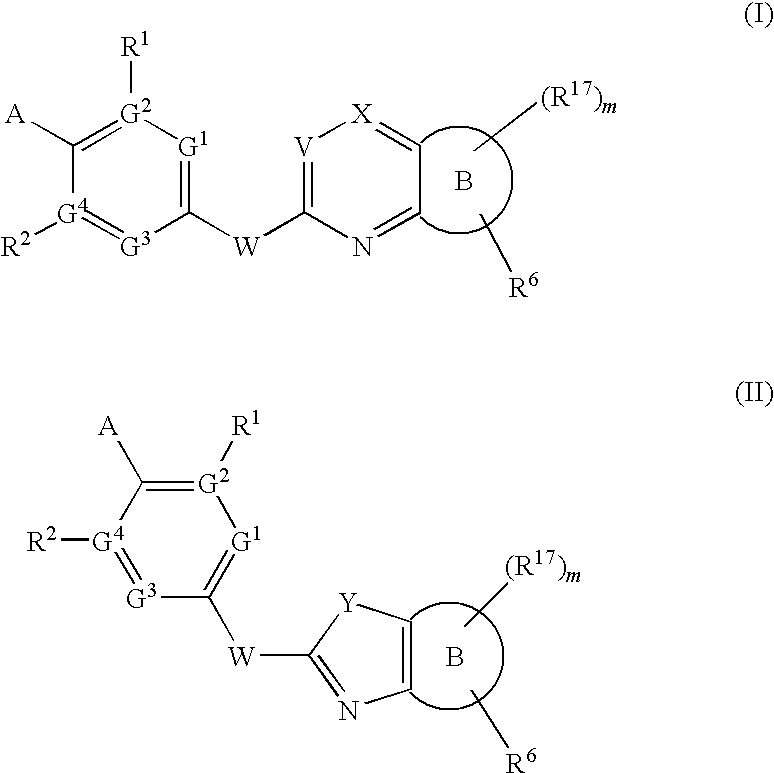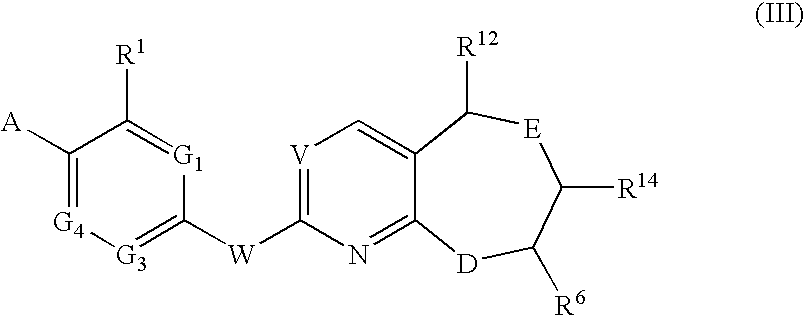Novel Compounds for A-Beta-Related Pathologies
a technology of abeta and compounds, applied in the field of new compounds, can solve the problems of a wide range of deleterious effects on neuronal function, and achieve the effects of maintaining notch signaling, lowering the secretion of a42, and increasing the secretion
- Summary
- Abstract
- Description
- Claims
- Application Information
AI Technical Summary
Benefits of technology
Problems solved by technology
Method used
Image
Examples
example 1
4-methyl-8-(4-(3-methyl-1,2,4-oxadiazol-5-yl)phenylamino)-2-phenyl-3,4-dihydropyrido[3,2-f][1,4]oxazepin-5(2H)-one
[0304]
[0305]A mixture of 8-chloro-4-methyl-2-phenyl-3,4-dihydropyrido[3,2-f][1,4]oxazepin-5(2H)-one (85 mg, 0.29 mmol), 4-(3-methyl-1,2,4-oxadiazol-5-yl)aniline (72.2 mg, 0.41 mmol), Pd(OAc)2 (6.61 mg, 0.03 mmol), biphenyl-2-yldicyclohexylphosphine (10.32 mg, 0.03 mmol) and Cs2CO3 (288 mg, 0.88 mmol) in DME (2 mL) was heated to 100° C. in a microwave reactor for 1 h. The reaction mixture was filtered, the solvent was evaporated and the residue was purified by HPLC to give 23.7 mg of product as a solid (19% Yield).
[0306]1H NMR (400 MHz, DMSO-d6) δ ppm 8.04 (d, 1H) 7.98 (m, 4H) 7.50-7.57 (m, 2H) 7.40-7.47 (m, 2H) 7.33-7.40 (m, 1H) 6.77 (d, 1H) 5.86 (t, 1H) 3.86 (d, 2H) 2.92 (s, 3H) 2.38 (s, 3H) 10.02 (s, 1H). MS m / z 428 [M+H] 426 [M−H].
example 1a
8-chloro-4-methyl-2-phenyl-3,4-dihydropyrido[3,2-f][1,4]oxazepin-5(2H)-one
[0307]
[0308]A solution of 2,6-dichloro-N-(2-hydroxy-2-phenylethyl)-N-methylnicotinamide (5.50 g, 16.91 mmol) in THF (50 mL) was slowly added to a ice-water cooled suspension of NaH (0.449 g, 17.76 mmol) in THF (50 mL). The resulting mixture was stirred over night while it was allowed to slowly come to room temperature. The reaction mixture was diluted with ethyl acetate, washed with saturated aqueous NaHCO3, water and brine, then dried over MgSO4 and evaporated. The residue was purified by column chromatography on Silica, using gradient elution with increasing concentration of methanol from 0 to 5% in dichloromethane, to give 2.66 g of the title product as a solid (54% Yield). 1H NMR (400 MHz, DMSO-d6) δ ppm 8.21 (d, 1H) 7.35-7.49 (m, 6H) 5.91 (m, 1H) 3.89-3.97 (m, 1H) 3.82-3.89 (m, 1H) 2.93 (s, 3H). MS m / z 289, 291 [M+H].
example 1b
2,6-dichloro-N-(2-hydroxy-2-phenylethyl)-N-methylnicotinamide
[0309]
[0310]2,6-Dichloronicotinoyl chloride (4.02 g, 19.10 mmol) was dissolved in THF (25 mL) and added dropwise to a solution of 2-(methylamino)-1-phenylethanol (3.47 g, 22.92 mmol) and Et3N (5.32 mL, 38.20 mmol) in THF (25 mL). The resulting slurry was stirred at room temperature for 16 h. The reaction mixture was diluted with ethyl acetate, washed with 1 M HCl, water and saturated aqueous NaHCO3, dried over MgSO4 and evaporated to give 6.259 g of the title product as a solid (quantitative). The product was used without further purification in the subsequent reaction. MS m / z 307, 309 [M−OH] 325, 327 [M+H] 383, 385 [M+OAc]
PUM
| Property | Measurement | Unit |
|---|---|---|
| temperature | aaaaa | aaaaa |
| temperature | aaaaa | aaaaa |
| temperature | aaaaa | aaaaa |
Abstract
Description
Claims
Application Information
 Login to View More
Login to View More - R&D
- Intellectual Property
- Life Sciences
- Materials
- Tech Scout
- Unparalleled Data Quality
- Higher Quality Content
- 60% Fewer Hallucinations
Browse by: Latest US Patents, China's latest patents, Technical Efficacy Thesaurus, Application Domain, Technology Topic, Popular Technical Reports.
© 2025 PatSnap. All rights reserved.Legal|Privacy policy|Modern Slavery Act Transparency Statement|Sitemap|About US| Contact US: help@patsnap.com



